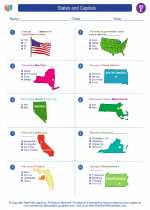States and Capitals -> functional regions
Functional Regions
Functional regions, also known as nodal regions, are geographic areas that are centered around a node or focal point. These regions are defined by the connections and interactions between the central point and surrounding areas. The characteristics that define a functional region include transportation networks, communication systems, economic activities, and other forms of interaction.
Characteristics of Functional Regions
- Node or Focal Point: Functional regions are centered around a specific point, which serves as the hub for interactions and connections.
- Interconnectedness: The surrounding areas within a functional region are closely linked to the central point through transportation, communication, and economic activities.
- Flow of Goods and Services: Functional regions often exhibit a flow of goods, services, and people towards the central node and back out to the surrounding areas.
- Functional Hierarchy: Some functional regions may have hierarchical structures, with multiple levels of nodes and subcenters that play different roles in the overall region.
Examples of Functional Regions
Functional regions can be found in various scales and contexts. Some common examples include:
- Metropolitan Areas: Major cities and their surrounding suburbs form functional regions based on economic activities, transportation networks, and daily commuting patterns.
- Trade Areas: Retail centers and shopping districts create functional regions based on the flow of goods, services, and consumer interactions.
- Transportation Networks: Airports, seaports, and major transportation hubs serve as focal points for functional regions that connect various locations through travel and trade.
- Communication Networks: Telecommunication and internet service providers create functional regions based on the reach and connectivity of their networks.
Study Guide
When studying functional regions, consider the following key points:
- What defines a functional region and how is it different from other types of regions?
- Examples of functional regions in different geographic and human-made contexts.
- The role of nodes or focal points in shaping the characteristics of functional regions.
- How interconnectedness and flow of goods/services contribute to the functionality of these regions.
- Real-world applications and implications of understanding functional regions in urban planning, economic development, and transportation management.
Understanding functional regions provides valuable insights into the complex interactions and networks that shape geographic spaces and human activities. It also helps in analyzing the spatial patterns of various phenomena and their impacts on society and the environment.
[Functional Regions] Related Worksheets and Study Guides:
.◂Social Studies Worksheets and Study Guides Fifth Grade. States and Capitals

 Worksheet/Answer key
Worksheet/Answer key
 Worksheet/Answer key
Worksheet/Answer key
 Worksheet/Answer key
Worksheet/Answer key
